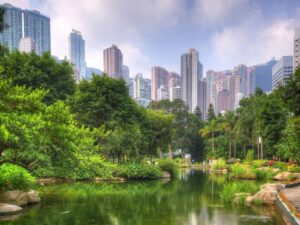Will Christie
Green space in cities is a modern phenomenon that has gained a lot of traction in science, media and politics in recent times and has been lauded for its benefits to urban populations – but is it really that simple?

Picture (needs source, BW)
As of 2020, 52% of the world’s population lived in an urban setting (Roberts, 2021) and a study in 2016 revealed that 1 in 5 adults in the United States suffered from some form of mental illness (Ha et al, 2022). The impact on the daily life of the affected person can be drastic; making it hard to go to work, maintain healthy relationships, and function normally in society. Governments must bear the economic costs and authorities have tried to combat the mental health crisis in recent years is by funding urban green space projects to improve the living conditions, mental health, and wellbeing of those in cities.
As well as improving living conditions, green space can improve the efficient functioning of a city. One way in which it does this is by cooling the surrounding environment, as trees and grass absorb less heat than asphalt, provide shade, and regulate temperature via evapotranspiration (nhm.ac.uk, 2022). Not only does this make cities more comfortable to live in, but it also reduces the need for air conditioning, in turn reducing energy demands, pollution and improving air quality. This effect is boosted by the natural pollution filtering effect of trees that absorb carbon dioxide and release oxygen photosynthetically.
Lack of green space can also drastically affect wildlife and the water cycle, harming aquatic systems and habitats in or near cities. When temperatures are high, warm water draining into rivers and lakes can lead to high mortality and aid the establishment of invasive species. Increased evaporation due to the urban heat island effect also leads to especially dry soils, making cities dead zones for all but the most adaptable species (Euro.who.int, 2022). Green space helps to mitigate against this effect by cooling streets, reducing runoff and providing habitat for wildlife.
But what about the human impact?
One study, conducted by Amano et al in 2018 (Amano et al, 2018), aimed to find out if green space had an effect on the overall health of urban residents across the world. Proximity to green space from 34 cities across 4 continents was correlated with public health data on life expectancy and infant mortality (not mental health). Interestingly, the results showed that green space is beneficial to overall health in wealthy cities, however, the opposite was true in poor cities. The authors linked this finding in poorer cities to the lower quality of green space, lack of public support and engagement, and lack of access that led to the green space being detrimental rather than beneficial for those residents. One can imagine an example where a large, densely forested park between a suburb and the nearest hospital might cause lower life expectancy and higher infant mortality for its poorest residents.
While this may be true on a global scale, in wealthier countries, such as England, populations that are exposed to the greenest environments actually have the lowest levels of health inequality related to income deprivation (Roberts et al, 2021). In such countries, green space is thought to improve health by providing people with areas to exercise, socialise and relax.
And mental health?
Green space has long been known to improve the mental wellbeing of city dwellers; however, various studies have shown that it’s not as simple as planting trees in a concrete jungle. Minimising the distance to green space for the maximum number of people yields the best effects on mental health. A study in Chicago this year (Ha et al, 2022) showed that more small green spaces spread throughout a city are better for mental health than fewer larger spaces. While it may seem that larger green spaces would be better because they provide areas to exercise, the main benefit of smaller, more frequent green space is that it provides people with everyday exposure to calming features in the landscape, for example on their commute to work. The study also found that forested areas are preferential to open fields because they provide a sense of safety and comfort, and relief from the harsh vistas of concrete and glass.
Not only is there heterogeneity in the quality of green space, but, as with the effects on overall health, different social groups experience varying levels of benefit from green space. Roberts et al (2021) showed that there was only a relationship between better mental health and green space in groups with high proportions of ethnic minorities and deprived households. Interestingly, this is in opposition to the effects found on overall health as mentioned earlier.
Conclusion
Green space has a multitude of benefits to cities and their inhabitants, however, seeing all green spaces as positive is an oversimplification of the issue. City planners and local governments need to consider multiple factors when implementing areas of greenery into urban environments and recognise that some are better than others. This will help the cities of the future to be more efficient and sustainable, and probably much nicer to visit!
Bibliography
Amano, T., Butt, I. and Peh, K., 2018. The importance of green spaces to public health: a multi-continental analysis. Ecological Applications, 28(6), pp.1473-1480.
Euro.who.int. 2022. [online] Available at: <https://www.euro.who.int/__data/assets/pdf_file/0010/342289/Urban-Green-Spaces_EN_WHO_web3.pdf%3Fua=1> [Accessed 14 April 2022].
Ha, J., Kim, H. and With, K., 2022. Urban green space alone is not enough: A landscape analysis linking the spatial distribution of urban green space to mental health in the city of Chicago. Landscape and Urban Planning, 218, p.104309.
Nhm.ac.uk. 2022. Why we need green spaces in cities. [online] Available at: <https://www.nhm.ac.uk/discover/why-we-need-green-spaces-in-cities.html#:~:text=Green%20spaces%20in%20cities%20mitigate,a%20result%20of%20human%20activity.> [Accessed 14 April 2022].
Roberts, M., Irvine, K. and McVittie, A., 2021. Associations between greenspace and mental health prescription rates in urban areas. Urban Forestry & Urban Greening, 64, p.127301.
Tropical Sky. 2022. Top 10 city parks in the world. [online] Available at: <https://www.tropicalsky.co.uk/travel-inspiration/top-10-city-parks-in-the-world> [Accessed 14 April 2022].